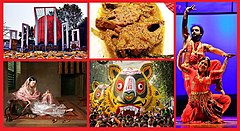
Shri Krishna Chaitanya Mahaprabhu was a 15th century Indian saint and founder of Achintya Bheda Abheda. Devotees consider him an incarnation of the god Krishna. Chaitanya Mahaprabhu's mode of worshipping Krishna with ecstatic song and dance had a profound effect on Vaishnavism in Bengal. He was also the chief proponent of the Vedantic philosophy of Achintya Bheda Abheda. Mahaprabhu founded Gaudiya Vaishnavism. He expounded Bhakti yoga and popularized the chanting of the Hare Krishna Maha-mantra. He composed the Shikshashtakam.
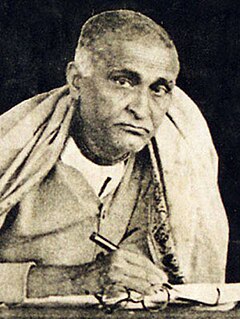
Bhaktisiddhanta Sarasvati, born Bimla Prasad Datt, was a Gaudīya Vaisnava Hindu guru, ācārya, and revivalist in early 20th century eastern India. To his followers, he was known as (Srila) Prabhupāda.

Śrī Nityānānda Rama Prabhu, is the Supreme Personality of Godhead, famous as a primary religious figure within the Gaudiya Vaishnava tradition of Bengal, being an expansion of Balarama. Nitai was Chaitanya Mahaprabhu's friend and disciple. They are often mentioned together as Gaura-Nitai or Nimai-Nitai. Followers often refer to Nitai as 'Sri Nityananda', 'Prabhu Nityananda' or 'Nityananda Rama'.

Gaudiya Vaishnavism, also known as Bengali Vaishnavism, Chaitanya Vaishnavism or the Gaudiya Vaishnava tradition, is a Vaishnava Hindu religious movement inspired by Chaitanya Mahaprabhu (1486–1534) in India. "Gaudiya" refers to the Gauḍa region of Bengal, with Vaishnavism meaning "the worship of Vishnu". Its theological basis is primarily that of the Bhagavad Gita and Bhagavata Purana, as interpreted by early followers of Chaitanya, such as Sanatana Goswami, Rupa Goswami, Jiva Goswami, Gopala Bhatta Goswami and others.
Chandidas refers to a medieval poet of Bengal or possibly more than one. Over 1250 poems related to the love of Radha and Krishna in Bengali with the bhanita of Chandidas are found with three different sobriquets along with his name, Baḍu, Dvija and Dina as well as without any sobriquet also. It is not clear whether these bhanitas actually refer to the same person or not. It is assumed by some modern scholars that the poems which are current in the name of Chandidas are actually the works of at least four different Chandidas, who are distinguished from each other by their sobriquets found in the bhanitas. It is also assumed that the earliest of them was Ananta Baḍu Chandidas, who has been more or less identified as a historical figure born in the 14th century in Birbhum district of the present-day West Bengal state and wrote the lyrical Srikrishna Kirtan.

Krishna Dasa Kaviraja Goswami was the author of the Chaitanya Charitamrita, a biography on the life of the mystic and saint Chaitanya Mahaprabhu (1486–1533), who is considered by the Gaudiya Vaishnava school of Hinduism to be an incarnation of Radha and Krishna combined.
The Chaitanya Charitamrita, composed by Krishnadasa Kaviraja in c. 1557, is written in Bengali with a great number of Sanskrit verses in its devotional, poetic construction, including Siksastakam. It is one of the primary biographies detailing the life and teachings of Chaitanya Mahaprabhu, the founder of Gaudiya Vaishnavism. The stories of Chaitanya's life are mixed with philosophical conversations detailing the process of Bhakti yoga, with special attention given to congregational chanting of Krishna's names and the Hare Krishna mantra.

Rupa Goswami was a devotional teacher (guru), poet, and philosopher of the Gaudiya Vaishnava tradition. With his brother Sanatana Goswami, he is considered the most senior of the six Goswamis of Vrindavan associated with Caitanya Mahaprabhu, a hidden avatar (incarnation) of Krishna in Kali Yuga.

Sanatana Goswami was a principal follower of Chaitanya Mahaprabhu. Sanatana wrote a number of important works in the bhakti tradition of Gaudiya Vaishnavism and was the seniormost of the influential Six Goswamis of Vrindavan, among whom was his brother Rupa Goswami.
Śrī Caitanya-bhāgavata is a hagiography of Caitanya Mahāprabhu (b.1486), the Supreme Personality of Godhead Krishna incarnation in Kaliyuga, written by Vrindavana Dasa Thakura. It was the first full-length work regarding Chaitanya Mahaprabhu written in Bengali language and documents his early life and role as the founder of the Gaudiya Vaishnava tradition. The text details Chaitanya's theological position as a combined Avatar of both Radha and Krishna within the belief of his close associates and followers. The writing of Chaitanya Bhagavata was commissioned by Nityananda, who was the guru of Vrindavana Dasa Thakura and close friend of Chaitanya Mahaprabhu.
Vrindavana Dasa Thakura or Brindaban Das was the author of the Chaitanya Bhagavata, the first full-length biography of Chaitanya Mahaprabhu written in the Bengali language.

Jiva Goswami was an Indian philosopher and saint from the Gaudiya Vaishnava school of Vedanta tradition, producing a great number of philosophical works on the theology and practice of Bhakti yoga, Vaishnava Vedanta and associated disciplines. He is known as one of the Six Goswamis of Vrindavan and was the nephew of the two leading figures, Rupa Goswami and Sanatana Goswami.
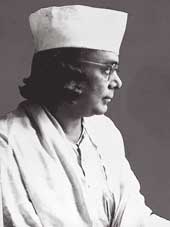
Bengali literature denotes the body of writings in the Bengali language. Bengali has developed over the course of roughly 1,300 years. The earliest extant work in Bengali literature is the Charyapada, a collection of Buddhist mystic songs dating back to the 10th and 11th centuries, and considered to be written in an ancestor language of Bengali, Assamese, Odia and many other languages belonging to the Eastern branch of the Indo-Aryan languages. The timeline of Bengali literature is divided into three periods − ancient (650-1200), medieval (1200-1800) and modern. Medieval Bengali literature consists of various poetic genres, including Hindu religious scriptures, Islamic epics, Vaishnava texts, translations of Arabic, Persian and Sanskrit texts, and secular texts by Muslim poets. Novels were introduced in the mid-19th century. Other than the Eastern Nagari script, Bengali has been written with different scripts such as the Perso-Arabic and Sylheti Nagri in certain parts of history. Nobel Laureate Rabindranath Tagore was the best known figure of Bengali literature to the world. Kazi Nazrul Islam, notable for his activism and anti-British literature, was described as the Rebel Poet and is now recognised as the National poet of Bangladesh.

Shreekrishna Kirtana Kabya or Sri Krishna Kirtana Kabya is a pastoral Vaishnava drama in verse composed by Boru Chandidas. It is considered to be the most significant work after Charyapada in the history of Bengali literature. These verses are believed to be written in the pre-Chaitanya era of the later half of 14th century CE.
Govindadasa was a Bengali Vaishnava poet known for his body of devotional songs addressed to Krishna. Living in an atmosphere of Krishna-bhakti preached by Sri Chaitanya (1486–1533), he composed extensively on the Radha-Krishna love legend. He is also known as Govinda Das Kaviraja.
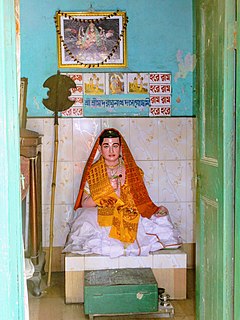
Raghunatha dasa Goswami, a.k.a. Dasa Goswami, was a disciples of the Śrī Yadunandan-ācārya one of the apostle of the Vaishnava saint, Chaitanya Mahaprabhu,, the primary six of which were collectively known as the Six Goswamis of Vrindavan. Together the Six Goswamis established the philosophical writings and records which became the theological basis of the Gaudiya Vaishnava tradition. Among the six, Raghunatha dasa was renowned for his qualities of simplicity and renunciation.
The Shikshashtakam is a 16th-century Gaudiya Vaishnava Hindu prayer of eight verses composed in the Sanskrit language. They are the only verses left personally written by Chaitanya Mahaprabhu with the majority of his philosophy being codified by his primary disciples, known as the Six Goswamis of Vrindavan. The Shikshashtakam is quoted within the Chaitanya Charitamrita, Krishnadasa Kaviraja Goswami's biography of Chaitanya Mahaprabhu, written in Bengali. The name of the prayer comes from the Sanskrit words Śikṣā, meaning 'instruction', and aṣṭaka, meaning 'consisting of eight parts', i.e., stanzas. The teachings contained within the eight verses are believed to contain the essence of all teachings on Bhakti yoga within the Gaudiya tradition.
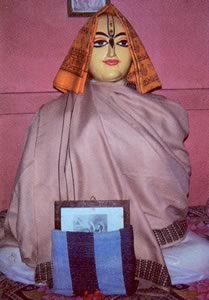
Haridasa Thakur was a prominent Vaishnava saint known for being instrumental in the initial propagation of the Hare Krishna movement. He is considered to be the most famous convert of Chaitanya Mahaprabhu, apart from Rupa Goswami and Sanatana Goswami. His story of integrity and unflinching faith in the face of extreme adversity is told in Chaitanya Charitamrita, Antya lila. It is believed that Chaitanya Mahaprabhu himself designated Haridasa as nāmācarya, meaning the 'teacher of the Name'. Haridasa Thakura, was a devotee of God, Krishna, and had practiced chanting the names of the Lord, Hare Krishna, 300,000 times daily.

The Vaishnava Padavali movement refers to a period in medieval Bengali literature from the 15th to 17th centuries, marked by an efflorescence of Vaishnava poetry often focusing on the Radha-Krishna legend. The term padavali has the literal meaning "gathering of songs".
The Six Goswamis of Vrindavan were a group of devotional teachers (gurus) from the Gaudiya Vaishnava tradition of Vedic religion who lived in India during the 15th and 16th centuries. They are closely associated with the land of Vrindavan where they spent much time in service of the Bengali saint Chaitanya Mahaprabhu, who is considered as Krishna's yuga-avatar by the Gaudiya Vaishnava lineage, who highly regard them for their extreme renunciation of physical comforts and pleasures in the practice of Bhakti Yoga, and for their philosophical presentations of the teachings of their guru, Chaitanya Mahaprabhu.


